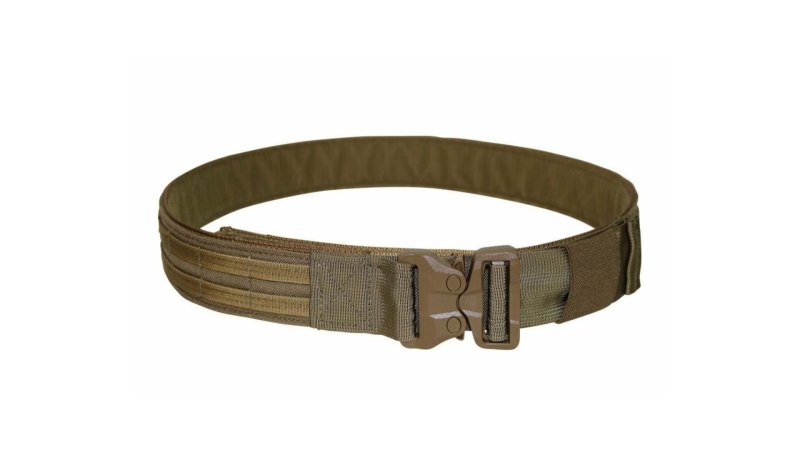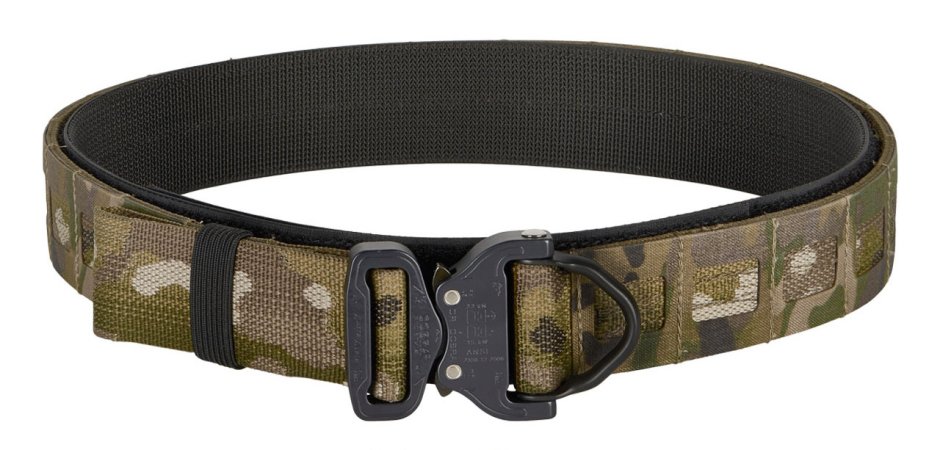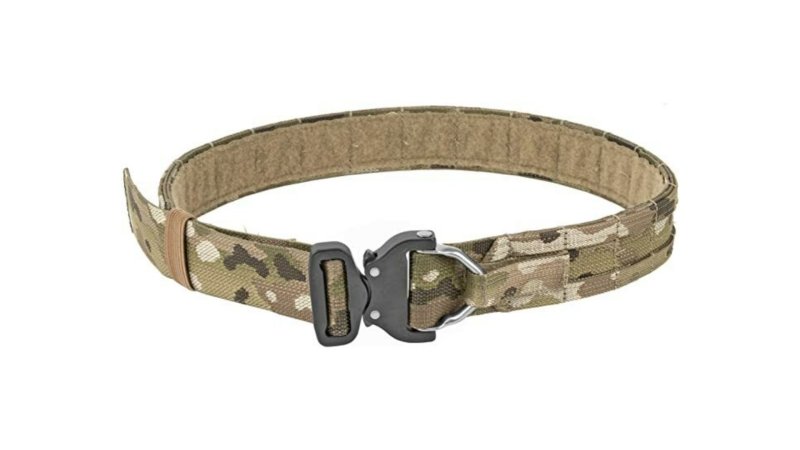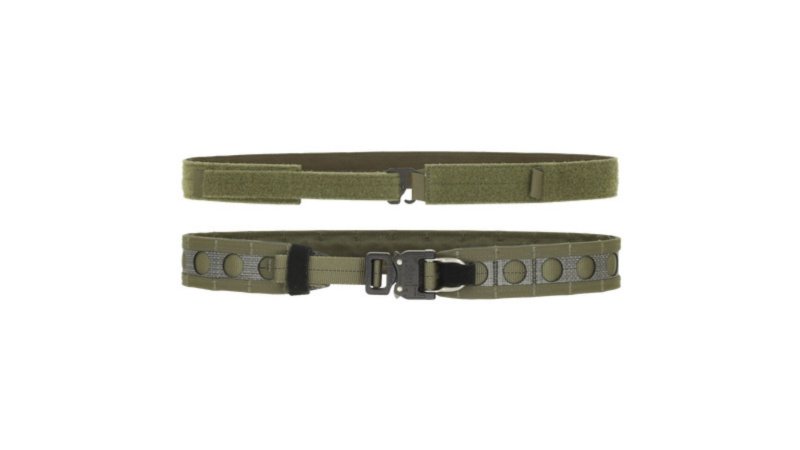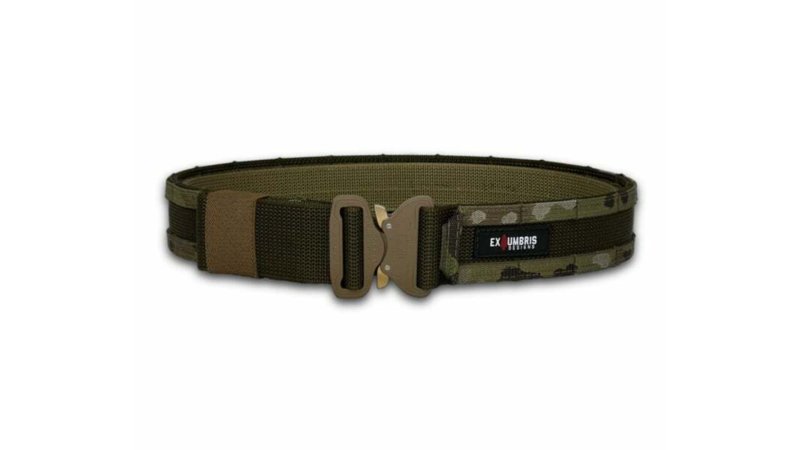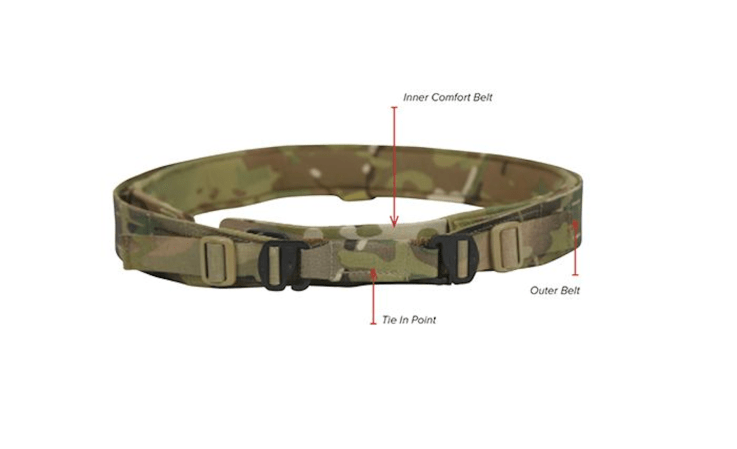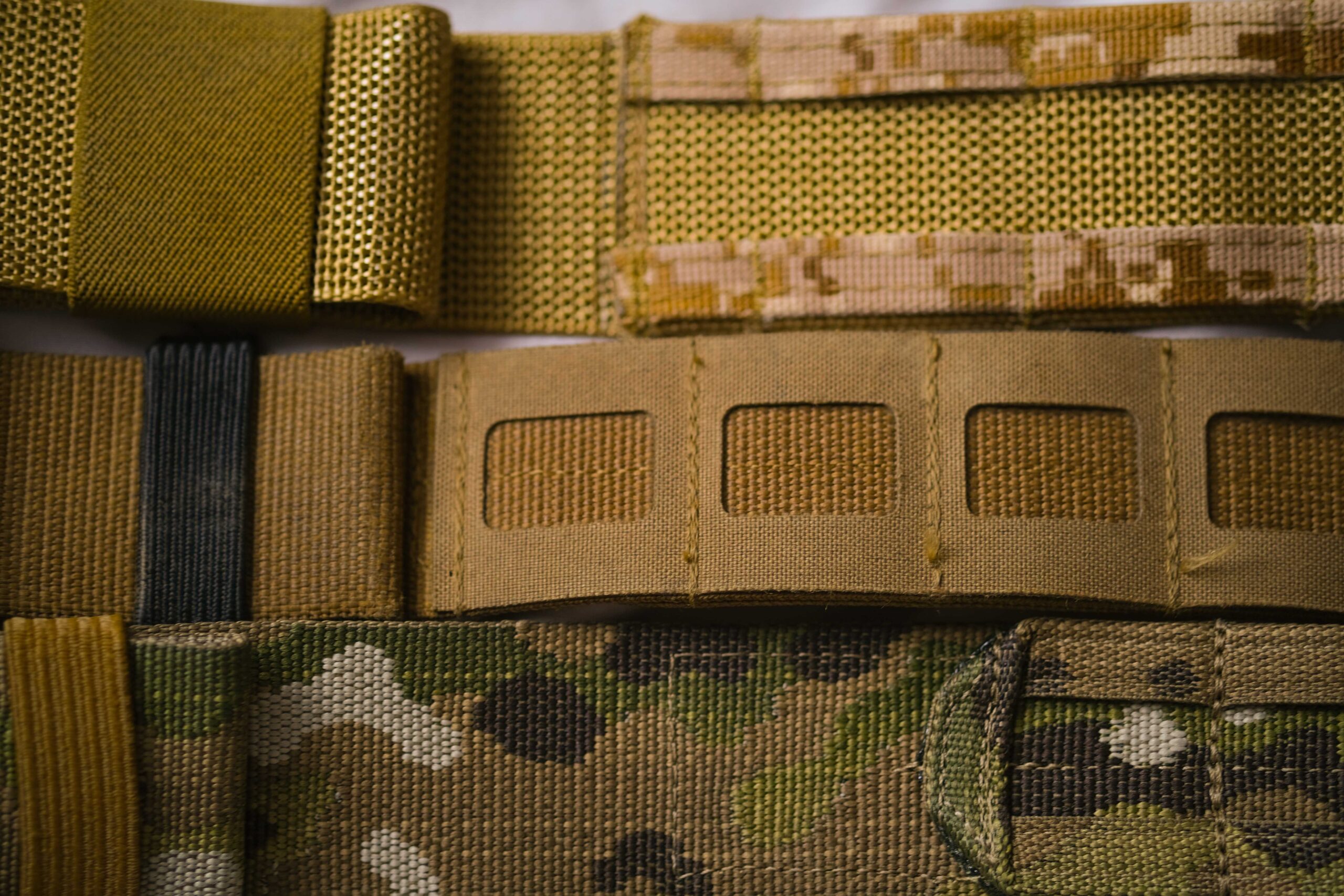

We may earn revenue from the products available on this page and participate in affiliate programs.
Gun belts, also known as gunfighter belts, battle belts, pistol belts, and many other names, are an easy way to carry weapons and ammo. The best gun belts do this through the use of superior materials, innovative designs, and rock-solid quality control.
We’ve compiled a list of our top picks in the various categories that are encompassed under the general moniker of “gun belts.” These move past the more traditional setup of a nylon belt with pouches attached, and feature design cues taken from the outer duty belts worn by many in law enforcement. So whether you’re looking for a belt to use at the range or in a military tactical environment, one of these will likely fit your needs.
As a rule, these products are made in the United States by top-tier companies, are suitable for military use, and have been thoroughly tested by Task & Purpose and our trusted experts.
Best Overall
AXL Advanced Eclipse Belt
Pros
- Featherweight
- Will not sag under pouch weight
- Affordable
Cons
- Weak velcro
- Unusual sizing
- Difficult to weave pouches
Product Specs
- Construction: Laminate and Tegris thermoplastic
- Velcro: Hook side low profile
- Available sizes: 28- to 44-inch waist
- Available colors: Black, Multicam, Ranger Green, Coyote Brown, Wolf Gray
Best Value
BDS Tactical Modular Shooter's Belt
Pros
- Affordable
- Wide color selection
- Durable material
Cons
- Budget buckle options are fragile
- Plain construction
- Limited production
Product Specs
- Construction: Nylon fiber and SCUBA webbing
- Velcro: Hook-side
- Available sizes: 28- to 44-inch waist
- Available colors: Black, Multicam Black, Multicam Arid, Multicam Tropic, Multicam, Wolf Gray, Coyote Brown, Ranger Green, Olive Drab, M81 Woodland
Editor’s Choice
AWS SMU Operator Belt
Pros
- Rock-solid brand reputation
- Low-profile
- Does not trade durability for weight and form factor
Cons
- Mildly expensive
- Hook-side Velcro may abrade clothes
- Limited color options
Product Specs
- Construction: Polymer laminate composite and high-tensile nylon
- Velcro: Hook-side
- Available sizes: 24- to 49-inch waist
- Available colors: Black, Coyote, Ranger Green, Multicam, Multicam with black webbing, Coyote with black webbing, Ranger Green with black webbing, and Woodland with black webbing
Best Budget Alternative
Eagle Industries Operator Gun Belt
Pros
- Secure
- Durable
- Will not abrade outer layers
Cons
- Completely different
- Velcro system Value may vary
- Inner belt sold separatel
Product Specs
- Construction: Nylon and polyethylene
- Velcro: Loop-side
- Available sizes: 29- to 49-inch waist
- Available colors: Black, Multicam Black, Multicam, Coyote Brown, Ranger Green, Olive Drab, Woodland
Best Hybrid Gun Belt
Ferro Concepts Bison Belt
Pros
- Almost no risk of sagging
- Extremely lightweight
- Easy to adjust
Cons
- Costly
- Limited sizing
- Limited colors
Product Specs
- Construction: Nylon and molded thermoplastic
- Velcro: Hook-side
- Available sizes: 30- to 49-inch waist
- Available colors: Black, Multicam, Coyote Brown, Ranger Green, Wolf Gray
Best Custom Gun Belt
Ex Umbris Designs Assault Belt
Pros
- Totally customizable
- Lifetime warranty
- Extremely durable
Cons
- Somewhat costly
- Bulkier than other options at this price
- Customization isn’t a factor for everyone
Product Specs
- Construction: Reinforced nylon
- Velcro: Hook-side
- Available sizes: 32- to 40-inch waist production, larger sizes available on request
- Available colors: Black, Multicam Black, Multicam, Coyote Brown, OD Green, Military Green, Desert Tan, M81, and combinations of these. Custom colors available
Best Load-Bearing Gun Belt
Su0026S Precision Belt-Modular
Pros
- Excellent load-bearing for use in vehicles
- Extremely lightweight outer belt
- One of the most comfortable belts on the market
Cons
- Complicated set-up
- Niche primary use
- Costly
Product Specs
- Construction: Thermoplastic, laminate, nylon, and padding
- Velcro: Hook-side
- Available sizes: 30-38
- Available colors: Coyote Brown, Multicam, Black
Why you should trust us
When writing this article, I drew from my own experience adapting my personal belt to the various tasks that I’ve had to take on, as well as drawing from the experiences of other users in various military branches, competitive shooters, and tactical law enforcement. To supplement this, I got hands-on time with the various belts on this list to ensure that every option got a fair shake. To test this, I made sure that every belt could effectively carry my preferred loadout, that I could easily attach pouches, and that once the pouches were attached, they fit without much slop or play.
Every belt that I put on this list is popular with military users because of its rock-solid build quality, load-bearing capability, and proven longevity in combat situations. Finally, in the cases of Ex Umbris and Eagle, I asked the company directly for any information that they could provide on their production process and build quality.
Key features of gun belts
Gun belts are separated into four major components: core, webbing, buckle, and retention material. These components determine how well your belt will fit, how well it carries your equipment, and whether or not it will last under the strenuous conditions that many users will put it through. A dependable gun belt will hold pouches with minimal slop or play, and it won’t twist under a heavy load or tear apart by passing foliage, debris, or other environmental factors.
Core material
The core material of any gunfighter belt is what makes it stiff enough to hold up magazines, lanyards, pistols, and other items without twisting or sagging. Different from the webbing material, it’s designed to be inflexible and provide a solid, stable base for all your attachments. This can be either SCUBA webbing, polyethylene, thermoplastic, or even steel in some cases.
MOLLE webbing material
The webbing material is what makes a gunfighter belt a gunfighter belt, allowing it to mount MOLLE accessories despite having a form factor similar to an ordinary web belt or rigger belt. It needs to be flexible enough to easily web your pouches through, but sturdy enough to withstand pulling, twisting, and other outside stressors.
In addition, it needs to be cut so that when a belt is laid flat, the loops open up to allow for easy pouch attachment, but when worn on the body, they tighten up to keep the pouches secure. The webbing can be folded MOLLE loops, laser-cut laminate, or thermoplastic loops.
Buckle
The buckle is the fastening device for the belt and the most crucial point of failure if not executed properly. The buckle is what keeps your belt together. The vast majority of gunfighter belts on this list have aluminum Austrialpin Cobra buckles, but some have plastic buckles that trade weight and cost for durability. Oftentimes, a buckle will feature a D-ring for attaching lanyards or for use in conjunction with a harness for climbing and rappelling.
Retention material
The retention material is what holds the belt onto the inner belt and provides stability for drawing magazines and pistols out of pouches and holsters. This can be a Velcro inner belt, a rubberized friction pad that attaches to the Velcro, or old-style belt keepers that hook behind your inner belt and over your outer belt.
Benefits of gun belts
The primary purpose of a gunfighter belt is to carry your equipment, whatever that may be. Whether it’s as simple as keeping a few magazines on one side, or the need to carry ammunition, batons, pepper spray, handcuffs, and a sidearm for law enforcement users, a good belt will do all this and more.
Load-bearing capability
The worth of a belt is decided by how well the belt stands up to the weight of your gear, and the best gun belts will do this by having a stiffened core that prevents twisting and sagging, without having rough, exposed edges that dig into your sides while moving. Additionally, many feature D-rings or reinforced fabric loops to attach a lanyard to, preventing you from getting flung out of a moving boat, aircraft, or ground vehicle due to a sudden movement.
Organization
Having an outer belt that mounts all of your magazines is advantageous because it allows you to remove your kit easily when done, or even to just use the restroom. Another advantage is that you can have various belt setups if your job truly requires it to accommodate for things like Sensitive Site Exploitation gear, versus a more direct action setup with magazines, versus a belt designed for shooting competition, all swappable without having to change your inner belt or pants. A final advantage is that you can have magazines or tools on you even when not wearing your plate carrier, allowing you to more easily carry all the essentials.
Gear balance
Sure, you can have 10 magazines, an IFAK, GP pouch, dump pouch, and microwave on your vest, but how comfortable are you when doing that for many hours and many miles? Realistically, the ability to spread the weight of one’s combat load between hips and shoulders is going to lessen the stress on one particular part of your body over another, and having your magazines mounted lower on your side may be easier for some people to reach in a hurry.
Pricing considerations
Budget
The low end of gunfighter belts is plagued with Chinese-made belts and imitators that are good for little beyond airsoft or cosplay. Most belts in this price bracket will feature shoddy stitching, inferior-quality materials, and inconsistent quality control. However, in this less-than $100 range, you can find the entry-level of the BDS catalog, as well as Eagle when they’re on holiday sale. Shop judiciously, and purchase from a reputable brand that actually sees military usage.
Mid-range
Between $100 and $200 is where most gunfighter belts retail for, as this is a price range that can allow for good quality materials and workmanship, while not going overboard with space-age production that drives the price up. Belts in this price bracket will feature consistent stitching, excellent quality materials, and battle-proven pedigrees. You won’t find many unique belts, however, and the majority of them can become a bit same-same, meaning that in this price bracket, it often boils down to personal preference.
Premium
Above $200, there are dragons. In this price range, you’ll find things like the Ferro Concepts Bison belt, which is legitimately innovative, but you’ll also find various other belts that I will not name, sold by personality-driven companies, as well as one-off boutique jobs. You will also find belts in limited edition or restricted colorways, since those are sold for the privilege of owning something that others can’t buy, and are best left for collectors. At this price bracket, you can pay for exotic materials and incredibly precise QC, but you can also be paying for an average belt in a fancy color.
How we chose our top picks
To build this list, I based it on products that I’ve personally used, along with interviews with professional end-users and the manufacturers themselves. I limited the belts on this list to tactical nylon “gunfighter belts” rather than expanding it to belts for concealed carry, padded “battle belts,” and leather duty belts for law enforcement use, simply because of the fact that those are topics in and of themselves, and this list would easily be an entire book if I included all of them.
You may notice that the Ronin Tactics Senshi belt is not on the list, and that’s mostly because Ronin belts are manufactured under contract by AWS, so I’d recommend AWS instead. The GBRS Group Assaulter belt is not on this list because for most users, the advantages over the Ferro Concepts Bison belt are not appreciable, and the Ferro belt is still lighter.
Finally, I’ve generally avoided companies that engage in “drop” marketing, as end-users who need a quality belt solution sooner rather than later aren’t always willing to wait for the next hyper-limited drop.
FAQs on gun belts
You’ve got questions, Task & Purpose has answers.
Q. What makes a good gun belt?
A. A good gun belt should be rigid enough to support your equipment, while also being flexible enough to move with your body. It should also be stable when worn with an inner belt, to prevent the belt from moving when you go to draw a magazine. All gun belts on this list satisfy this need.
Q. What kind of gun belt should I get?
A. Your gun belt should be scaled to your needs. If you’re not someone who needs to carry more than three rifles magazines or a few items of gear on a vest, then you can possibly do without. If you’re a law enforcement officer whose department requires you to wear all weapons and ammo on a belt, then a quality gunfighter belt is essential. The same goes for people who are in military occupations where they have to wear a pack with kidney straps, as with my Mystery Ranch Observed Fires Pack.
Q. Does a gun belt make a difference?
A. A quality gun belt absolutely makes the difference between efficient gear carrying and more awkward options, whether they be carrying all your ammo and gear on a plate carrier or chest rig, or weaving holsters and ammo pouches directly into a conventional belt.
Q. Is a gun belt worth it?
A. For those who need an easy-on and easy-off option to carry all of their essential gear, and that is separate from a plate carrier or chest rig, a quality gun belt is absolutely essential.

